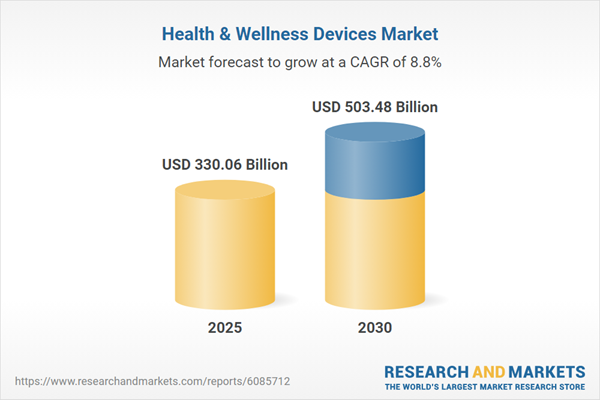Speak directly to the analyst to clarify any post sales queries you may have.
The health & wellness devices market is rapidly evolving as technology and healthcare converge, transforming how individuals and organizations approach personal well-being and chronic condition management. Integrated solutions are now an essential part of daily routines and care strategies, driving demand for devices adapted to a broad spectrum of use cases and end users.
Market Snapshot: Health & Wellness Devices Market
The health & wellness devices market experienced significant growth, with revenues expanding from USD 304.09 billion in 2024 to USD 330.06 billion in 2025. It is projected to maintain robust momentum, achieving a compound annual growth rate (CAGR) of 8.76% and reaching USD 503.48 billion by 2030. Market dynamics are shaped by rising consumer adoption, technological advancements, and increasing emphasis on preventive care. The sector now encompasses a diverse array of solutions, with innovation and strategic partnerships at the core of competitive positioning.
Scope & Segmentation
This comprehensive report delivers actionable insights across the entire health & wellness devices market, segmented for strategic relevance:
- Device Types: Fitness & activity trackers, including bands, sensor-enhanced footwear, smartwear, and smartwatches; medical devices such as hearing aids, insulin pumps, glucose and blood pressure monitors, EEG and fetal monitors, pulse oximeters, smart scales, sleep apnea solutions, spirometers, thermometers, nebulizers, and oxygen concentrators; personal care devices; therapeutic devices.
- Connectivity Technologies: Wired as well as wireless options leveraging Bluetooth, cellular, and Wi-Fi networks for seamless device integration.
- Distribution Channels: Both online and offline platforms, reflecting shifting consumer behavior and operational models.
- Applications: Chronic disease management (cardiovascular, diabetes, hypertension, respiratory), fitness and wellness (activity tracking, rehabilitation, posture, sleep, weight management), mental health and stress relief, and personal care (oral health, skincare, hair care, anti-aging).
- End Users: Hospitals and clinical providers, individual/home users, and sports/fitness centers across the institutional and consumer landscapes.
- Geographies: Americas (including North and Latin America), Europe, Middle East, Africa, and Asia-Pacific, encompassing key markets such as the US, China, Germany, India, Brazil, and emerging regions with diverse maturity and regulatory environments.
- Company Developments: The analysis covers major market participants including Apple, Medtronic, Samsung Electronics, Philips, Garmin, OMRON Healthcare, Huawei, Abbott Laboratories, and other leading innovators and suppliers.
Key Takeaways for Senior Decision-Makers
- Collaboration is accelerating between device manufacturers and digital technology providers, enabling integration of artificial intelligence and advanced analytics for predictive insights and tailored wellness recommendations.
- Telehealth and remote patient monitoring are reshaping care delivery, pushing development of health devices that support real-time clinical engagement and data transmission beyond traditional settings.
- Modular hardware design and over-the-air software updates are emerging as critical differentiators, allowing customized product offerings and rapid iteration aligned with evolving user needs.
- Regional trends highlight the importance of understanding distinct regulatory frameworks and reimbursement strategies, influencing market entry and product adaptation in Western Europe, Asia-Pacific, and North America in particular.
- Agile supply chain management and ecosystem interoperability are vital as competitive intensity rises, enabling stakeholders to respond swiftly to disruptions and embrace new partnership opportunities.
Tariff Impact: Navigating Changing Trade Environments
The 2025 introduction of US tariffs on imported health and wellness devices is driving manufacturers and distributors to evaluate cost structures and sourcing strategies. Companies are pivoting toward local and regional production, establishing flexible logistics capabilities, and engaging in compliance initiatives to reduce tariff exposure. Understanding regulatory pathways and participating in trade preference programs are crucial steps to safeguard profitability and maintain continuity in supply.
Methodology & Data Sources
Proprietary research fundamentals combine primary interviews with key opinion leaders and industry executives, in-depth secondary analysis of regulatory filings, clinical literature, and industry reports, as well as validation with external experts. A bottom-up analytical model was employed to triangulate shipment, adoption, and market penetration data, ensuring robust, evidence-based insights.
Why This Report Matters
- Empowers C-level executives to make informed strategic decisions by clarifying emerging trends, supply chain challenges, and digital transformation opportunities in the health & wellness devices market.
- Delivers competitive intelligence, highlighting innovation strategies, ecosystem partnerships, and the regulatory landscape, supporting effective market entry and product differentiation.
- Guides investment prioritization by illuminating high-growth segments, regional demand shifts, and critical success factors for sustainable expansion.
Conclusion
The health & wellness devices market is entering a new phase shaped by innovation, technology convergence, and adaptive supply chains. Strategic adoption of interoperable solutions, data stewardship, and global-local adaptation will drive value creation for organizations seeking leadership in this transformative sector.
Table of Contents
3. Executive Summary
4. Market Overview
7. Cumulative Impact of Artificial Intelligence 2025
Companies Mentioned
The companies profiled in this Health & Wellness Devices market report include:- Aerotel Medical Systems Ltd.
- AgaMatrix, Inc.
- Apple Inc.
- Blue Spark Technologies, Inc.
- Boston Scientific Corporation
- Drägerwerk AG & Co. KGaA
- Garmin Ltd.
- GE HealthCare Technologies Inc
- Huawei Investment & Holding Co., Ltd.
- Medtronic PLC
- Microlife Corporation
- OMRON Healthcare, Inc.
- Koninklijke Philips N.V.
- Abbott Laboratories
- Siemens Healthineers AG
- Stryker Corporation
- Becton, Dickinson, and Company
- Fujifilm Holdings Corporation
- Smith & Nephew PLC
- ResMed Inc.
- BioMérieux S.A.
- Zimmer Biomet Holdings, Inc
- Sony Group Corporation
- Xiaomi Group
- Alphabet Inc
- Samsung Electronics Co., Ltd.
- iHealth Labs Inc.
- ZOLL Medical Corporation
- Ouraring Inc
Table Information
| Report Attribute | Details |
|---|---|
| No. of Pages | 186 |
| Published | November 2025 |
| Forecast Period | 2025 - 2030 |
| Estimated Market Value ( USD | $ 330.06 Billion |
| Forecasted Market Value ( USD | $ 503.48 Billion |
| Compound Annual Growth Rate | 8.7% |
| Regions Covered | Global |
| No. of Companies Mentioned | 30 |









